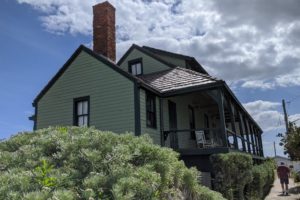Remember at the end of the posts about the Alexander Graham Bell museum we had a picture of an older Casey Baldwin and that he was responsible for the Cabot Trail drive? Well, we’re taking that drive today. It’s along the coast to the northern part of Cape Breton and back south on the other side. Today we’re just driving the eastern side to the tip of the island and then back down since the full drive would have taken too much time.

The Cabot Trail was named after the Italian explorer John Cabot who reached the shores in 1497 and honors the meeting of Cabot and the Mi’kmaq people over 500 years ago. Completed in 1932, the Cabot Trail’s 185-mile loop connects previously isolated communities with intriguing histories, including Acadian, Irish, and Scottish settlements.
But first we had to take a ferry just a short distance across a bay to save us about 30 minutes of driving.




Cabot Trail

The trail was dotted with various artists shops. The first was a pewter shop.




And then there was a chocolate shop inside of an art shop.

more of our beautiful drive on this fall day


time for lunch
Some other travelers we had met told us about the Keltic Lodge as a place to eat. It’s in the Cape Breton Highlands National Park. We stopped at the lodge, but they only served meals to paying guests. So we drove to the resort’s public restaurant, Arduaine (name comes from a tiny hamlet in Scotland).




More red chairs with a beautiful view.



drive back to the ferry


ferry back home


A heavy cable pulled us across the pull of the tide to the other side.

So I’m sure you picked up the Scottish influence on Cape Breton, so let’s find out about it. The weekend we’re here starts the annual Celtic Colors featuring music, art, piping, dancing, and story telling all over the island. In Inverness on the western side of Cape Breton, many of the people actually still speak Gaelic. Golf courses are everywhere.
history of Scottish people in Cape Breton (from websites on Nova Scotia)
The name Nova Scotia is Latin for “New Scotland” and was first given to this part of North America in 1621 by Sir William Alexander of Menstrier (a village in Scotland). He appealed to King James of Scotland that a “New Scotland” was needed to expand national interests alongside New England, New France, and New Spain. Nova Scotia became an ideal territory for early Scottish settlers.
Although a few Scots were among the early settlers, they didn’t come in large numbers or establish permanent communities until 1773 when emigrants from the northwestern coast of Scotland arrived in Pictoum, NS, at the place where we arrived on the ferry from Prince Edward Island. This wave of adventurous Highlanders came from all over Scotland to settle throughout Nova Scotia.
In 1775 Michael MacDonald—the man responsible for many more Scots to come here— came to the western shore of Cape Breton Island from Prince Edward Island. A poet and sea captain, he and his relatives had left Scotland a few years earlier. MacDonald encouraged his family and friends to join him in the area now known as Inverness County. They welcomed the opportunity to acquire their own land and to begin farming and fishing. And so began the Scottish settlement on Cape Breton Island.
These Pictou Scots were Presbyterian and spoke Scottish Gaelic. Many of their descendants later moved to other parts of Canada and the United States, but each summer Pictou residents continue to celebrate the arrival of the ship Hector with its founding immigrants.
why they came here
The early Scottish settlers were attracted here by the prospect of owning their own property free from the demands of landlords and by the possibility of providing better opportunities for their children. Scotland, like Ireland, was over-populated and unable to support them. Emigration was a necessity, even though they lamented leaving homes and relatives behind.
leaving Nova Scotia
Out-migration of Scots from Nova Scotia began almost as soon as major immigration ceased. Frustrated by poor crops and a weak economy, boatloads set sail in the 1850s for Australia and New Zealand, seeking better living conditions. Others moved to Ontario and New England, particularly to the Boston area where thousands of their descendants live today. Many also found their way to the mining towns of the western United States.
After being in the land of the Scots today, we decided to start watching season 1 of Outlander on Netflix to get our Scottish fix. What an interesting show: Barney loves the idea of time travel, and we both get to see what life was like in 1743 in the Highlands of Scotland. In the episode we just watched, we learned about the Jacobite rising in 1745 that was the beginning of the end of the clans.




